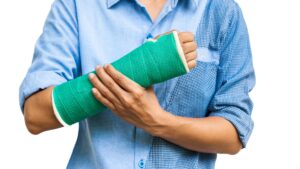Fracture is a common injury. According to a survey, millions of people break a bone every year.
Fracture can occur due to several reasons, such as accidents, trauma, repetitive motion, or osteoporosis. Their treatment varies depending upon their symptoms, severity, age of the individual, the health of the individual, the bone affected, and others.

COMMON CAUSES OF FRACTURES ARE:
-
- TRAUMATIC INCIDENTS
Traumatic incidents may harm our bodies. Whether it is a car accident or a fall from a significant height, they can generate substantial force on our bones or shatter them into multiple fragments.
-
- REPETITIVE MOVEMENT
Hairline fractures or stress fractures are mainly a result of repetitive physical movements in an area. These might develop due to excess movements or increased activity exerting high pressure or stress on the bones. Due to this, these are also termed stress fractures.
-
- HIGH FALLS
Falling from a significant height might result in a break of a bone, ligament, or muscle. Fall from heights is a high-energy injury that leads to shock or pressure on a particular body part and thus leads to fractures. These falls result in injuries concerning multiple body regions.
Osteoporosis is a bone disease that weakens the bones and makes them brittle. In this condition, there is a decrease in bone mineral density and bone mass with a change in bone strength, thus increasing the risk of broken bones and fractures.
THINGS TO AVOID IF A PERSON BREAKS A BONE
-
- The person might feel in shock after being injured. If the person feels faint, takes fast breaths, or feels uneasy, lay down the person to help them feel comforted.
-
- Try to stop the bleeding by applying pressure on the wound. Always use a sterilized bandage or a clean cloth to touch the affected area.
-
- Applying ice packs helps ease pain, discomfort, and swelling. Always wrap the ice in a towel or a cloth before applying it to the skin.
-
- Do not try to treat the injured on your own. Look for professional medical care.
-
- Avoid taking unauthorized medication.
-
- Do not move, jerk, or apply unnecessary force or pressure on the fractured bone. Otherwise, it may complicate things.

TREATMENT
Various treatment options adopted for different fractures are:
DIAGNOSTIC MEASURES
-
- X-RAYS
X-rays provide a clear picture of the degree of damage caused due to fracture. These are mainly used to have a clear and closed look at the bones and joints. While deciding the apt treatment for a bone fracture or any other injury, it is crucial to study the impact of the injury.
-
- MRI SCANS
MRI Stands for Magnetic Resonance Imaging. It is a medical imaging procedure used to study conditions or injuries that affect soft tissues or ligaments of our body. An MRI scan uses magnetic fields and radio waves to take images of our body’s interior.
-
- FRACTURE IMMOBILIZATION
For timely healing, it is crucial to align fractured bones in their proper place. Setting a bone is referred to as reduction. In reduction, the doctor will push or pull the ends of the fractured bone until they line up. If reduction does not work, one might need surgery.
Not all fractures require surgery. Some fractures require non-surgical treatment options.
If the fracture is not severe, the person might only require a splint or cast. It helps avoid movement of the affected area and thus reduces pain.
If the bone is not immobilized, the injured bones, ligaments, or tendons might incur more damage.
Braces immobilize a body part following an injury. Braces are adjustable and thus assist in providing alignment to the bones, ligaments, or tendons.
Casts provide more support than braces and are most commonly used to immobilize a fractured bone. A cast prevents the fractured bone from moving. These are also customized to fit the person and are durable.
Slings are a simple way of immobilizing an arm. It is a bandage folded in a triangular shape, placed under the arm, and then tied around the neck.
SURGICAL MEASURES
Some bone fractures require surgeries such as –
-
- INTERNAL FIXATION
To ensure the healing of the bone, the doctor will align the bones in their correct position. In internal fixation, the doctor inserts metal pieces into the bone, including rods, plates, screws, pins, etc.
-
- EXTERNAL FIXATION
It involves inserting screws in the bone on either side of the fracture and then connecting them to a brace around the bone outside the body.
-
- ARTHROPLASTY
It refers to a joint replacement where the damaged joint is removed and replaced with an artificial joint.
In conclusion, fractures are common injuries caused by various factors, including accidents, sports activities, and osteoporosis. Timely medical care is essential for effective healing and to prevent any complications.
As we know, prevention is better than cure. We should adopt measures in our everyday life to reduce the risk of fractures.
-
- One of the main preventive measures taken is keeping your bones healthy and strong by ensuring proper intake of a balanced diet.
-
- Consuming nutrients and vitamins in adequate amounts is essential for maintaining your physical and mental health.
-
- One should include physical exercises in their routine to help improve bone health.
-
- Studies suggest that individuals with osteoporosis are at an increased risk of fractures, especially in the spine, hip, wrist, humerus, and pelvis. So, one should be careful about their health to avoid medical complications.
Know more about bone health and the strategies adopted for maintaining bone health at https://glyraorthopaedics.com/2023/07/07/bone-health-strategies-for-maintaining-strong-bones/
By staying informed, one can ensure well being of one’s bones and enjoy a long healthy life.
Book your appointment with Dr. Rahul Grover today https://glyraorthopaedics.com/
STAY HEALTHY, STAY STRONG
